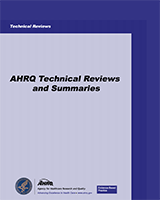NCBI Bookshelf. A service of the National Library of Medicine, National Institutes of Health.
Structured Abstract
Objectives:
To identify and summarize evidence from controlled trials on the efficacy and tolerability of drug treatments for the prevention of migraine.
Search strategy:
A strategy combining the MeSH term “headache” (exploded) and a previously published strategy for identifying randomized controlled trials were used on the January 1966 to December 1996 MEDLINE database. Other computerized bibliographic databases, textbooks, and experts were also utilized.
Selection criteria:
We selected English-language controlled trials involving patients with migraine headache in which at least one treatment offered was a drug given regularly during headache-free intervals with the aim of preventing the occurrence of migraine attacks.
Data collection and analysis:
Measures of headache index and headache frequency reported as group means (and standard deviations) were used to calculate standardized mean differences (or effect sizes). The number of patients obtaining at least a 50% reduction in headache index, frequency, or severity was recorded and used to calculate odds ratios. Where similar trials provided data, meta-analysis of efficacy measures was performed. The identity and rates of adverse events were recorded and statistically compared.
Main results:
Placebo-controlled trials support the efficacy of several drugs for the prevention of migraine. Drugs with multiple placebo-controlled trials suggesting at least moderate efficacy include: propranolol (effect size, 0.55; 95% confidence interval, 0.42 to 0.69), timolol (0.69; 0.18 to 1.2), sodium valproate and divalproex sodium (0.93; 0.39 to 1.5), naproxen sodium (0.29; 0.01 to 0.57), amitriptyline (0.62; 0.15 to 1.1), methysergide (no effect size estimate), flunarizine (0.52; 0.24 to 0.80), pizotifen (0.91; 0.50 to 1.3), and lisuride (no effect size estimate). Other beta-blockers demonstrated efficacy similar to that of propranolol, except for those with intrinsic sympathomimetic activity, which did not appear to be efficacious. Within other, more diverse drug categories -- such as antidepressants, calcium antagonists, and anticonvulsants -- there was more variability in the efficacy of different agents. Except for the comparison of propranolol with flunarizine, equivalence has not been demonstrated among the various agents found to be efficacious in placebo-controlled trials. Many efficacious preventive drugs were poorly tolerated in the reviewed trials and were associated with substantial rates of patient withdrawals.
Conclusions:
Several specific agents have been shown to be efficacious for the prevention of migraine; however, there are few data to guide the choice among agents, and poor tolerability and lack of availability in the U.S. limit the usefulness of many of the drugs reviewed.
Contents
Project Directors: Douglas C McCrory, MD, MHSc, David B Matchar, MD. Project Manager: Rebecca N Gray, DPhil. Research Assistants: Patricia Weston, RN, Susan Farese, RN, Pramod Gumpeni, BA. Technical Advisors: Joel Saper, MD, George Sands, MD, Barry Baumel, MD, Harvey Blumenthal, MD, James Couch, MD, Jerome Goldstein, MD, Herbert Markley, MD, Alan Rapoport, MD, Sherry Siegel, MD, Jerry Swanson, MD, Jerome Walker, MD. AHCPR Project Officer: Ernestine Murray, RN, MAS.
Prepared for: Agency for Health Care Policy and Research, Department of Health and Human Services, U.S. Public Health Service, Rockville, Maryland. Contract No. 290-94-2025. Prepared by: Center for Clinical Health Policy Research, Duke University.
Suggested citation:
Duke University, Center for Clinical Health Policy Research. Drug Treatments for the Prevention of Migraine Headache. Technical Review 2.3. February 1999. (Prepared for the Agency for Health Care Policy and Research under Contract No. 290-94-2025. Available from the National Technical Information Service; NTIS Accession No. PB99-127953.)
This document does not necessarily represent the views of the Department of Health and Human Services. It is available from the National Technical Information Service at 1-800-553-6847.
